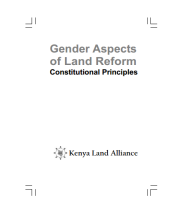/ library resources
Showing items 1 through 9 of 15.Throughout this pocket size booklet, Land Reform Volume 4, KLA proposes that collectively as a nation, and especially during this time of the constitutional review process.
This information paper illustrates sustainable dryland management practises in communities vulnerable to climate change with case studies in India and the Sudan.In both cases the adaptation programme is presented, including infrastructural strategy and social involvement, followed by results of t
The World Bank Group (WBG) has the potential to improve the contribution of extractive industries (EI) to sustainable development and poverty reduction.
Mineral wealth often detracts from, rather than enhances, the economic performance of developing countries, a phenomenon known as the “resource curse”.
This paper starts from the optimistic assumption that the policies required for environmentally sustainable economic development are known but difficulties surround their implementation.
What does community based natural resource management (CBNRM) mean for Mozambique's poor?Through the case study of Derre Forest Reserve in Zambezia province, this paper explores the theory and practice of CBNRM, an approach which has been widely promoted in southern Africa, and is central to elem
This document summarises the main points in the conclusions and recommendations sections of the World Bank’s Final Report of the Extractive Industries Review (EIR).
With an estimated 40 percent of people in Africa, South America and Asia living in drylands, land degradation poses a significant threat to food security and survival.
Pagination
Land Library Search
Through our robust search engine, you can search for any item of the over 73,000 highly curated resources in the Land Library.
If you would like to find an overview of what is possible, feel free to peruse the Search Guide.



